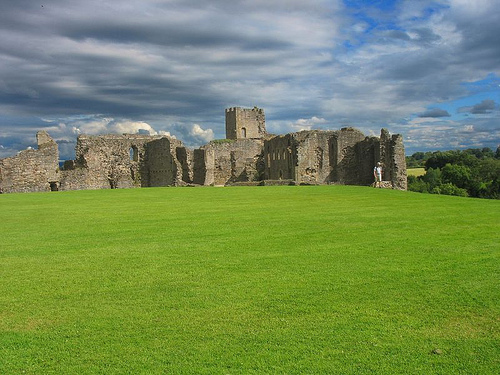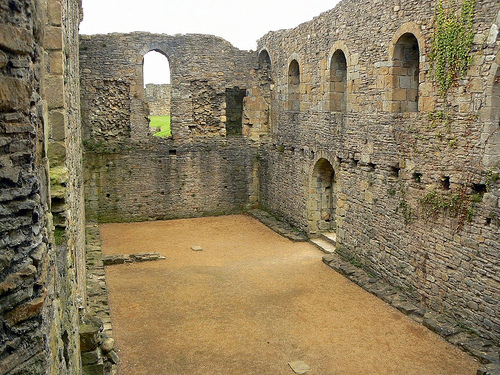

Location: Tower Str, Richmond, North Yorkshire Map
Tel. 01748 822493
Entrance Fee: adults £4.50, children £2.30
Open: Oct- Apr: Thu- Mon
May- Sep: to 4pm daily

Richmond Castle is a medieval citadel in Richmond, North Yorkshire United Kingdom. Richmond Castle construction began in 1071 by Alain Le Roux de Ponthievre of Brittany (also known as Alan the Red) upon orders of William of Conqueror who erected a series of fortress across England to secure his newly acquired possessions. A location for a new citadel was chosen on the banks of River Swale. In the 12th century Duke Conan the Little of the fortress constructed a 100 feet tall keep that rises over the rest of the hill. Its walls measured 11 feet (3.4 meters) in thickness. In case the castle fell it was the site of the last resort for the defenders. Today you can reach the top of the tower and take a look around the Richmond Castle. The castle did not see much action through its history. Eventually it was abandoned and fell in disrepair. In 1855 Richmond Castle served as headquarters of North Yorkshire Militia and a site of military barracks. These barracks briefly served as a home to Boy Scouts in 1908- 10. Eventually these new additions were demolished to preserve medieval appearance of the fortress. During World War I Richmond Castle served as a site for Non-Combatant Corps English conscientious objectors (usually for religious reasons) who refused to fight in Europe, but were conscripted anyway.

In 1069, William the Conqueror had crushed a rebellion in York
that was followed by the Harrying of the North - an act of
ethnic cleansing that depopulated large parts of the country for
a generation or more. As a further punitive action, he divided
the lands of north Yorkshire between his most loyal supporters.
Alain the Red of Brittany was given the borough of Richmond and
began building the castle to secure himself against further
rebellion and establish a personal power base. His lands, called
the Honor of Richmond, spanned eight counties and amounted to
one of the most extensive Norman possessions in England. The
Dukes of Brittany became owners of the castle as Earls of
Richmond, although over the centuries it was often confiscated
by the English kings for periods.
At the end of the 12th
century, Duke Conan IV had a 30-meter high keep made of
honey-colored sandstone built. The Earldom of Richmond was
conquered by King Henry II in 1158. Presumably Henry II also had
the donjon with its 3.3 meter thick walls completed. Today's
visitors can climb the keep, which offers great views. At the
same time as the keep was being completed, Henry II
significantly strengthened the castle's fortifications by adding
towers and a barbican. The Kings Henry III. and Eduard I
invested more money in the castle, Eduard z. B. also in the
improvement of the fixtures in the keep.
In addition to
the main ring of walls, there was a barbican in front of the
main gate, which functioned as its own enclosed entrance room,
where visitors and chariots could be examined before being
admitted into the castle proper. On the other side of the
castle, across the river, there was another separate room or
bailey called the cockpit, which probably served as a garden and
which a balcony overlooked. A drawing from 1674 shows another,
longer balcony on the river side of Scolland's Hall, the Great
Hall.
Richmond Castle was abandoned as a fortress towards
the end of the 14th century and has not been expanded since that
time. A report from 1538 shows that the castle was already
partly in ruins, but paintings by William Turner and other
painters, the rise of tourism and a growing interest in antiques
led to the keep being repaired in the early 19th century.
In 1855 the castle became the headquarters of the North
Yorkshire Militia and a large block of barracks was built in the
large courtyard. For two years, from 1908 to 1910, Robert
Baden-Powell, later founder of the Boy Scouts, lived at Richmond
Castle while he commanded the Northern Territorial Army. The
barracks buildings were removed again in 1931.
During
World War I, the castle served as a base for the Non-Combatant
Corps, a unit of the British Army made up of conscientious
objectors. The castle also served as a prison for conscientious
objectors who opposed any kind of military discipline and did
not want to take part in the war in any way, even in a
non-combat capacity. This included the Richmond Sixteen, who
were then sent to France from the castle, tried under martial
law and sentenced to death. Their death sentences were
immediately commuted to 10-year labor camp terms. In 1919 they
were released from prison.
Richmond Castle stands today
as one of the finest examples of Norman buildings in Britain,
particularly Scolland's Hall, the castle's great hall. The
keep's roof and ceilings have been restored. The arch of the
11th-century main entrance, closed by the construction of the
new keep in the 12th-century, is now open again. This arch is
now in the basement of the 12th-century keep. It was closed
during the construction of the new keep in order to stabilize
the keep and the new main entrance was moved to the location
visible today.
The castle is a Scheduled Monument, a
nationally important historic building and archaeological site
that has been protected against unauthorized alteration. It is
also listed as a Grade I Historic Building and is therefore
recognized as an Internationally Important Building. Today the
castle is managed by English Heritage, who have also published a
guide by John Goodall. There is also a visitor center with a
display of artefacts from the castle's history and events
throughout the year.
According to legend, King Arthur and
his knights sleep in a cave under the castle. They are said to
have been discovered by a potter named Thompson, who ran away
when they began to wake up. Another legend tells that a drummer
boy got lost in an underground tunnel and his ghostly drumming
can be heard in and around the castle.
Richmond Castle consists of four main parts: a triangular main wall, the outer wall to the east, a keep in the north corner of the main wall and a small wall surrounding the keep.
Although Richmond Castle saw only few skirmished with the local population it still keeps secrets and legends that are retold by generations. One of these legends claim that underground tunnels exist that connects it to the Easby Abbey nearby. Others even tie these legends with the legendary King Arthur and the Knights of the Round Table. A local man by the name of Potter Thompson went for a walk after a bitter fight with his annoying wife. He reached the base of the Richmond Castle and discovered an entrance to the cave underneath the medieval citadel. He entered it and started walking. Eventually he discovered himself inside a large chamber with beautiful arches that held the old ceiling. Inside this room he discovered well preserved bodies of a great king and several knights in medieval armor. Besides a king Mr. Thomson found the legendary sword Excalibur and a horn. Obviously the local man tried to grab the sword, but as he did it all the knights in the chamber woke up. A failed thief threw down Excalibur and ran for the entrance. He didn't stop until he reached the surface. However once he looked back to make sure the knights awakened by his actions did not follow him, he saw a solid earthworks of the castle. The secret cave was gone and the secret of the final burial place of king Arthur became a legend that is retold to this day.